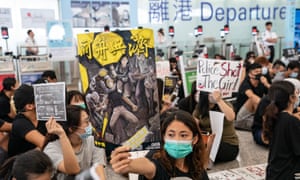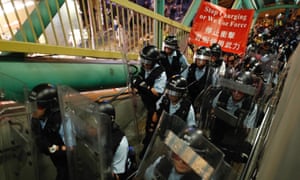Source: The Guardian (8/14/19)
Beijing’s game plan for stifling the Hong Kong protests is now clear
By Sebastian Veg
Manipulation of public opinion and pressure on the region’s businesses, universities and judiciary are part of the strategy

The departure hall of Hong Kong international airport on 13 August: ‘Beijing has engaged in a battle to turn public opinion in Hong Kong against the movement.’ Photograph: Anthony Kwan/Getty Images
As protests in Hong Kong against a controversial extradition law enter their third month, the prospect of any resolution to the unrest seems a long way off. However, the past week has given an indication of the strategy of the governments in Beijing and Hong Kong in dealing with protesters.
The growing pro-democracy movement achieved early success in June with the suspension of the proposed bill that would have allowed the extradition of suspects from Hong Kong to mainland China. This followed unprecedented peaceful demonstrations that brought up to two million people on to the streets and, separately, police violence. When Hong Kong’s chief executive, Carrie Lam, declared that she was shelving the bill, the Beijing authorities, having distanced themselves from the unpopular law, seemed to be lying low.
After forcing a climbdown from the Hong Kong government in June, protesters furthered their campaign in early July, when a small group broke in to Hong Kong’s Legislative Council. There, the occupiers laid out five demands: the withdrawal of the extradition bill; the retraction of the government’s characterisation of the protests as riots; an independent investigation into police violence; amnesty for arrested protesters; and the implementation of universal suffrage. At that time they commanded widespread support in society. The movement had been using an innovative “be water” technique to take on the authorities, encompassing moving occupations around the city, outreach to mainland tourists via “airdropped” flyers, and leaderless coordination through messaging apps and social networks. The protesters seemed to be learning lessons from the failures of the “umbrella revolution” of pro-democracy action in 2014.
In late July and early August, the People’s Daily, the mouthpiece of China’s Communist party, published various commentaries that seemed to outline an unfolding strategy to counter the protests. The pieces drew a distinction between violent extremists who have used opposition to the extradition law amendment bill as a pretext for other goals, and the vast majority of the Hong Kong public, who were called upon to unite against unruly protesters. The gist of this line was repeated in press briefings by Lam, and by Zhang Xiaoming, director of the Hong Kong and Macau affairs office in Beijing, in a meeting with 300 members of Hong Kong’s pro-Beijing elite in Shenzhen last week.

‘The Hong Kong police have been given the task of tasked with suppressing demonstrations at any cost.’ Photograph: Vincent Yu/AP
The Hong Kong police have been given the task of suppressing demonstrations at any cost. A previous commander has been brought back out of retirement, and this week, police were forced to admit that plainclothes officers had infiltrated protesters. Similarly, the judiciary will come under further pressure from the prosecution, which will use politicised charges and expedited procedures.
Next, patriotic forces will be mobilised to reunify the extremely disunited pro-establishment camp: businesses will face disproportionate retaliation or boycotts if they do not actively oppose the protests; universities and public institutions in Hong Kong will be brought back under control through internal discipline. This will raise the cost of sympathising with and participating in the anti-government movement for ordinary protesters. Indeed, pro-establishment politicians immediately lined up behind Beijing’s wording, putting an end to calls for Lam’s resignation or an independent inquiry into police violence.
Finally, Beijing has engaged in a battle to turn public opinion in Hong Kong against the movement and to isolate the “violent extremists” from the “patriotic silent majority”, especially by highlighting the economic impact of protests. Depictions of the protests as instigated by “foreign forces” were stepped up.
Beijing continues to rely on a “strategy of attrition” – one that served them well during the 2014 unrest. But at the same time, China continues to hint at the possibility of a military crackdown, releasing videos showing troop carriers moving to the border.
The Chinese government position is no doubt driven by fear of contagion to the mainland and geopolitical anxiety about Hong Kong’s loyalty. This must be balanced against the need to maintain Hong Kong’s perceived stability and prosperity, and to safeguard China’s influence in Taiwan.
The protesters’ challenge will be to steer clear of responding to police provocations with violence – a pitfall they did not avoid during the airport occupation of recent days – and to keep public opinion on their side. Recent surveys show that the wider public is indeed concerned about the escalating conflict.
While the leaderless “be water” strategy has served the growth of the protest movement well, it has also emerged as a liability, because there is no forum to coordinate a return to non-violent tactics or possible negotiations with authorities. Finding an exit strategy is almost always the most difficult part of anti-government mobilisation, and it remains unclear how the spiral of violence can be halted now.
• Sebastian Veg is a professor of contemporary history of China at EHESS, Paris. His most recent book is Minjian: The Rise of China’s Grassroots Intellectuals